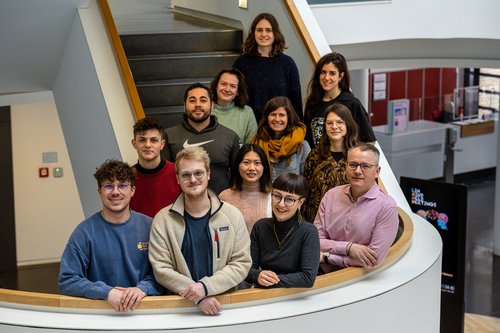Sensory learning and prediction
During our everyday life we pursue different, sometimes simultaneous actions. For example, we notice that we are going to run out of milk and therefore have to go shopping later. We are able to do this because we can plan things and hence postpone them. However, to successfully postpone one action in favor of another, we have to remember what we actually wanted to do. For example, we might remember from time to time that we have to buy milk and our consciousness shifts to what we just remembered. But it would be very dangerous to ignore another simultaneous task (to observe the environment while driving) just because we remember that we have to buy milk. While we think about milk, we still have to process information from the environment. It would be helpful to try to bridge these phases of mind wandering (towards the empty fridge) by allocating attention resources to extract information from the environment (switching traffic lights) in order to consciously perceive them.
In our group we are investigating two important questions:When and why does our brain independently retrieve things from memory? And: How can we continue to learn the structure of the environment in order to make predictions, even though we are mentally busy with other things? Answering these questions helps to understand how our brain learns to improve our interaction with the environment.
Our long-term goal is to understand how automatic memory retrieval and implicit learning are represented and interact at different physiological levels of the brain. This could help to better understand diseases like depression or ADHD.
- Head
Head

Stefan Dürschmid studied education and psychology in Magdeburg. After his doctoral thesis with Jochem Rieger and Hermann Hinrichs, he was a visiting scholar in the working group of Robert Knight at the University of California in Berkeley from 2013-2014, where he also spent regular working stays in recent years.
In addition, he has a long-term cooperation with the Hebrew University of Jerusalem (Prof. Leon Deouell) and collaborates with Prof. Giulio Tononi (University of Wisconsin, Madison).
In addition to his fascination with neuroscience, he is an enthusiastic violinist with several chamber music ensembles.
- Members
Members
Head Dr. Stefan Dürschmid +49 391-6263-92531 sduersch@lin-magdeburg.de PhD students Franziska Bischoff Xinyun Che Paul Schmid Medical PhD students Enes Bilgin David Eckert Andre Maric Master students Ardiansyah Esmondo Christiane Petzold Annemarie Scholz Bachelor students Michelle Horn Lisa Schüler Students and guests Benedikt Auer Roland Hanke Tom Weischner Alumni (with thesis) Anneke Bies (Msc) Julius Bittner (Bsc) Silvia Mössinger (Msc) Lena Vogelgesang (Msc) Nike Walter (Msc) Christian Wienke (Msc) - Projects
Projects
We are interested how the brain integrates information at different physiological levels.
Predictive coding – promoted in recent year as the primary function of the brain – considers the brain a 'predictive machine' tuned to predict sensory information or motor outcomes. Despite intense interest in the predictive capacity of the brain, there is no consensus on how prediction is implemented and controlled by different cortical brain structures. We analyze cortical responses in the tradition of using prediction error (PE) signals as a signature of predictive coding. However, whereas PE signals are a good proxy for predictions, what the field is missing to establish predictive coding directly, is true predictive (prospective) signals – signals that precede an event and indicate active anticipation of a particular event. That is, PE signals may be elicited with no active pre-stimulus anticipatory predictions involved if every stimulus is compared retrospectively, once encoded, to extant passive ‘memory models’. Critically, while many studies found indirect evidence for predictive coding in the form of PE signals, direct evidence for the actual prediction is hard to find. Most importantly, how the brain gains insight into regularities of the environment by representing statistical information to form such predictions is unclear.
At a cortical network level, the functioning of the human brain requires the coordinated electrical activity of neurons well-tuned to process information. It has been suggested that neuronal activity at rest is organized in avalanches of events in which event size show no characteristic scale and displays critical dynamics. Such dynamics are associated with optimal information processing even though the brain is not capable of processing all available information at once. A fundamental mechanism to selectively enhance the information integration of certain stimuli is provided by attention. However, it remains unclear how attention improves information capacity and whether it affects the coordinated electrical activity of neurons. Given that human resting activity displays criticality and focused attention helps optimize information processing, we study avalanche distribution of feedback and feedforward networks during attention modulation.
At a behavioral level we test whether and how behavioral relevant information are integrated. Impulsive decisions are proposed to arise from the tendency to overvalue smaller but sooner rewards or from being an insufficient consideration of objective values. In our group we investigate on a fine-grained temporal scale behavioral and oscillatory dynamics supporting impulsive decisions in conditions varying in the value for themselves and consequently in the amount of reward. Based on eye tracking and MEG recordings, we identify how differences in scrutiny of choice evaluation and hence the level of information integration predicts differences in discounting.
At a consciousness level we study subjective awareness which is governed by fluctuations of the mind (mind wandering) and probe its impact on perception and meta-cognition and their MEG/EEG correlates.
- Funding
Funding
2021-2024
DFG grant (SFB 1436)
„Neural Resources of Cognition“
2021-2024
LIN Special Project
„At the edge of the external world – the physiological basis of mind-wandering and its impact on attentional resourcesa” - Selected Publications
Selected Publications
2021
Wienke C, Bartsch M V., Vogelgesang L, Reichert C, Hinrichs H, Heinze H-J, Dürschmid S. Mind-wandering is accompanied by both local sleep and enhanced processes of spatial attention allocation. Cerebral Cortex Communications, 2021
Dürschmid S, Maric A, Kehl MS, Robert T Knight RT, Hinrichs H, Heinze HJ. Prefrontal cortex regulation of subjective valence to suppress impulsivity in intertemporal choices.Journal of Neuroscience, 2021.
2020Vogelgesang L, Reichert C,Hinrichs H, Heinze, HJ, Dürschmid S.Early Shift of Attention is Not Regulated by Mind-Wandering in Visual Search. Frontiers in Human Neuroscience, 2020.
Dürschmid S., Reichert C., Walter N., Hinrichs H., Heinze H.J., Ohl F.W., Tononi G., Deliano M.Self-regulated critical brain dynamics originate from high frequency-band activity in the MEG. PLoS ONE, 2020.
Wienke C, Bartsch M V., Vogelgesang L, Reichert C, Hinrichs H, Heinze H-J, Dürschmid S. Local sleep during mind-wandering enhances processes of spatial attention allocation. BioRxiv
2018Dürschmid S, Reichert C, Hinrichs H, Heinze HJ, Kirsch HE, Knight RT, Deouell LY. Direct evidence for prediction signals in frontal cortex independent of prediction error. Cereb Cortex. 2018.
2017
Dürschmid S, Reichert C, Kuhn J, Freund HJ, Hinrichs H, Heinze HJ. Deep Brain stimulation of the Nucleus Basalis of Meynert attenuates early EEG components associated with defective sensory gating in patients with Alzheimer disease – a two-case study. EJN. 2017. Available from: 10.1111/ejn.13749
2016
Dürschmid S, Edwards E, Reichert C, Dewar C, Hinrichs H, Heinze HJ, Kirsch HE,Dalal SS, Deouell LY, Knight RT. Hierarchy of prediction errors for auditory events in human temporal and frontal cortex. Proc Natl Acad Sci U S A. 2016. Available from: 10.1073/pnas.1525030113
Dürschmid S, Zaehle T, Hinrichs H, Heinze HJ, Voges J, Garrido MI, Dolan RJ, Knight RT. Sensory Deviancy Detection Measured Directly Within the Human Nucleus Accumbens. Cereb Cortex. 2016. Available from: 10.1093/cercor/bhu304
- Teaching & internships
Teaching & internships
Stefan Dürschmid teaches students of Psychology at the OVGU in the subjects General Psychology and Biological Psychology.
We are looking for motivated students from the subjects psychology, neuroscience, engineering, medicine and computer science with basic knowledge of a programming language (Matlab, Python etc.) for master theses or doctoral theses on the topic of stastic learning, attention fluctuation and decision making.
We are also looking for ambitious cellists with many years of chamber music experience who are not afraid of Beethoven and Schubert.


